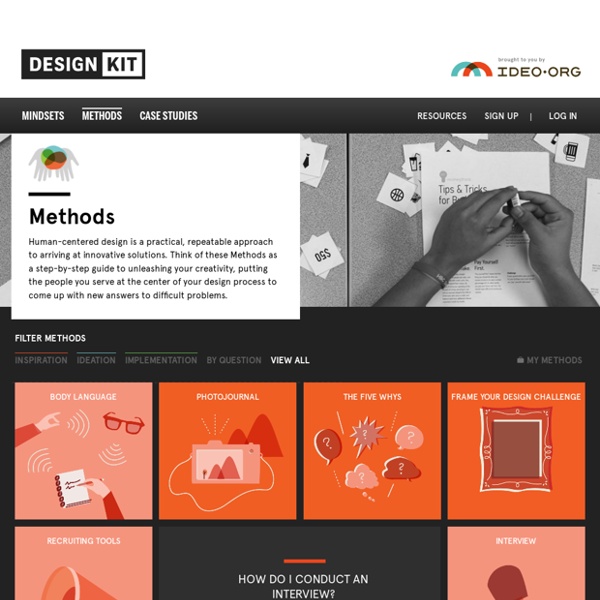Design Kit
http://www.designkit.org/methods
Related: Method cards
• DESIGN DE SERVICES
Resources
The resources page is a place for learning. Whether you have a contribution on OpenIDEO that you're excited to develop, or you're applying human-centered design offline, these assets are a great place to start. Building Your Team Teams are integral to collaborative problem solving. Learn more about how you can maximize teamwork.
Design Kit: The Human-Centered Design Toolkit
In April 2015, IDEO.org launched an exciting new evolution of the HCD Toolkit the Field Guide to Human-Centered Design. The Field Guide is the latest in IDEO.org’s suite of teaching tools and a step forward in sharing the practice and promise of human-centered design with the social sector. A full-color, 192-page book, the Field Guide comes with 57 design methods, the key mindsets that underpin how and why IDEO.org believes design can change lives, a full slate of worksheets, and case studies from projects that show human-centered design in action. The Field Guide was funded by more than 1300 backers in a Kickstarter campaign that reaching nearly three times its initial goal. IDEO.org received an amazing outpouring of support and strengthened its deeply held belief that human-centered design can push the social sector forward.
Title
Logon ka toh kaam hai hi kehna, but for us, it is the ‘logo’ which does the speaking. Brands are always looking ahead to come up with something that is unique and appealing to show up in the market. Logos are such visual representation to promote public recognition. Mostly, brands prefer vibrant and relatable graphics to be their logo.
Interaction Design Foundation
Design Thinking is a design methodology that provides a solution-based approach to solving problems. It’s extremely useful in tackling complex problems that are ill-defined or unknown, by understanding the human needs involved, by re-framing the problem in human-centric ways, by creating many ideas in brainstorming sessions, and by adopting a hands-on approach in prototyping and testing. Understanding these five stages of Design Thinking will empower anyone to apply the Design Thinking methods in order to solve complex problems that occur around us — in our companies, in our countries, and even on the scale of our planet. We will focus on the five-stage Design Thinking model proposed by the Hasso-Plattner Institute of Design at Stanford (d.school). d.school is the leading university when it comes to teaching Design Thinking. The five stages of Design Thinking, according to d.school, are as follows: Empathise, Define (the problem), Ideate, Prototype, and Test. 1.
Design Thinking for Educators
Design thinking is a mindset. It is the confidence that everyone can be part of creating a more desirable future, and a process to take action when faced with a difficult challenge. That kind of optimism is well needed in education. Classrooms and schools across the world are facing design challenges every single day, from teacher feedback systems to daily schedules.
Methods
Methods We’ve lined up a number of activities to help you understand, define, make, and release circular innovations. Dive in wherever makes most sense for you and your team.Don’t worry about getting it all right on your first go. The more you prototype and learn, the greater your positive impact on the system.
Repository
Design activities Co-designing Envisioning Testing & Prototyping Implementing Representations
How to Create a User Persona
How are you going to reach your target audience? You might not find your grandma on Twitter and you’re sure as not going to find your 12 year old nephew reading the Wall Street Journal. If your audience is a tech savvy college student, the best way to reach them might be online & social media. A teenager might be better reached through television ads through traditional media. From your research, you should have a good picture of what sort of channel your audience is primarily using or can be found on.
Related:



Coleção de métodos ou técnicas que podem ser usados durante as atividades do DT, São mostrados para cada uma das fases guias passo a passo para favorecer a criatividade, e colocar as pessoas envolvidas no centro do processo de design, permitindo assim que respondam de forma inovativa aos problemas complexos existentes. Exemplos: Entrevistas, Brainstorm, Definição de Sucesso, by professorfreire Oct 3